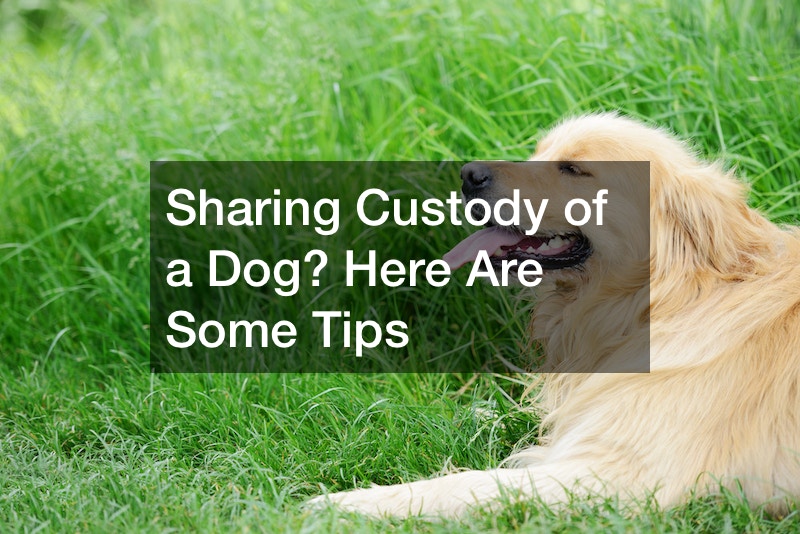
Sharing custody of a beloved dog can be a challenging but necessary decision in some cases, such as divorce or separation. Much like shared custody of children, it requires thoughtful planning and communication between all parties involved. It is essential that you give serious consideration to several areas that will affect the care that your dog gets. Open communication and other factors are essential in the management of sharing a dog successfully. Sharing Custody of a Dog? Here are some tips to do it successfully.
1. Continuity is Critical
Going back and forth between homes can be confusing for a dog. Just like it can be a bit confusing for a child. It is essential that you and the co-parent of the dog follow the same routine with the dog to ensure continuity of care. Making sure the same routine is in place in both locations will help reduce the risk of behavior problems developing.
Continuity of care is also important for outside care providers. For example, in the early stage of sharing custody, you must use the same boarding kennel you always have if you and the other dog parent are going to be out of town at the same time. You don’t want to switch providers because it can cause an upset for the dog and result in the development of unwanted behaviors.
Use the same services you always have for your dog. Don’t switch doggy day care service even if it means you have to drive a little further because you moved to pick up your pooch. It is more important in the early days of shared custody that everything else stays the same for your dog. Sticking with the same services will make it easier for your pet to adjust to the new normal of being switched back and forth. Sharing Custody of a Dog? Here are some tips coming up that will help you deal with unwanted behaviors.

2. Expect Problem Behaviors to Develop
Sometimes, even if you don’t change anything else, unwanted behaviors develop because of the stress of the change. The first thing you want to do is to contact your veterinarian (this is a good idea even if bad behaviors don’t develop; we discuss why in the next paragraph). Your vet will provide a checkup to ensure that your dog’s health hasn’t changed and health issues can be ruled out as a potential cause of unwanted behavior.
As a side note, will you share custody of a dog? Here are some tips for what you should ask the vet. First, inquire about pet vaccines that they should have if they are going to be moving back and forth between two households. For example, if you have moved out and now live on a lake, your dog may need special vaccinations if they are going to swim in the lake.
If your dog gets a clean bill of health and the unwanted behaviors continue, you may need to consider hiring a dog trainer to get rid of the unwanted behaviors. Don’t believe the hype that an old dog can’t learn new tricks; they can. Any dog is trainable with the right support. Don’t give up on the dog because they have developed some new behaviors. There is help.
3. Problems With Shared Custody
While it is true the biggest potential problem if you are sharing custody of a dog is managing co-parenting, but it is not the only potential problem. A rarely thought about problem when you are sharing custody is fleas. Flea control is essential for any dog, but it takes on a different level of importance when a dog is traveling from house to house. A couple of fleas at one house can turn into an infestation at two houses.
Fleas are not only an annoyance they can be vectors for disease, and they don’t only bite dogs and cats; they bite humans as well. Sharing Custody of a Dog? Here are some tips for managing fleas and protecting your dog. First, ensure that you and the co-owner are on board with the importance of managing flea care. Second, agree on which pet care supplies you will use and ensure that you are using the same supplies in each house.
If the situation gets out of hand, it can be very difficult to reel things back in. The best way to approach flea management is to have a discussion with the vet and the co-owner about which products you will use to prevent an infestation and how they will be used. For example, will you alternate treatments with each co-owner committing to providing the treatments on alternate schedules? It is important that you have this discussion and come to terms with how this will be managed.

4. Open Communication is Essential
Sharing Custody of a Dog? Here are some tips for learning how to talk about the dog and its care. Once the divorce lawyer has pulled out of the courthouse parking lot and you and your ex have reached an agreement about co-ownership of the dog, that conversation will have to keep going. It is essential to the successful co-ownership of a dog that each party can communicate about the dog. For example, you must be able to tell the co-owner if your dog’s stomach seemed upset during your time together.
If one co-owner will be traveling, it is essential that the other is made aware so they can provide care for the pooch. Open communication may be difficult at first, especially if it was a difficult breakup, but it is essential for the dog’s health and happiness that each co-owner is able to talk about plans, care, and other pertinent information involving the dog.
Some co-owners limit contact by doing everything via text message. Some attorneys will stipulate in the agreement that communication is made by text or email. However, you don’t need an attorney to tell you how to communicate with the co-owner. You should communicate using a method you feel most comfortable with.
Clearly, setting communication boundaries is fine as well. If you don’t want to converse about anything but the dog, set that boundary at the onset of this new relationship. Sharing custody of a dog? Here are some tips for things not to do. Don’t put it on the kids to provide information about the dog. Don’t withhold information, and don’t fail to respond to the co-owner’s questions about the dog. It’s important that both parties are willing to talk about the dog.
5. Decide These Things Early On
Sharing custody of a dog? Here are some tips for setting rules up for shared custody. There are some things you need to consider co-ownership. As a matter of fact, both parties need to consider these things. First, who will oversee paying for vet bills and other care like grooming? Will costs be split 50/50? Or will the person in possession of the dog during the grooming appointment cover that cost?
It doesn’t matter if you cover the costs of grooming this month and your co-owner covers the cost next month, or you can split the costs 50/50 upfront. However, it is important that you have frank discussions about what costs each of you are responsible for. Dog care can get expensive. Of course, you can also set up a joint account that each party contributes to weekly or monthly for dog care expenses. If you decide to choose this option, ensure that you have clear guidelines for what constitutes an “expense”.
Some co-owners decide that any expense that the dog may have can come out from a joint account; others decide that only vet bills will come out of this account. It doesn’t matter what you decide about how spending will be divided or how you will contribute, but it is strongly recommended that you and your co-owner set up clear rules for covering costs.
Sharing a dog? Here are some tips for what to do if your co-owner won’t pay their share. If the co-owner is not paying their part, you should first speak to the co-owner. Perhaps they have run into some financial trouble. If they are just refusing, you can consider hiring an attorney to adjust your custody agreement until they can start paying their fair share. However, use the attorney as a last resort; do all you can to try to work things out.

6. Make This Part of the Agreement
For the sake of avoiding future problems, there are a few services that you should come to an agreement about. Choosing providers together is essential to maintaining a harmonious relationship. You don’t want there to be any confusion over which pet health clinic is caring for the dog. You will have to agree on a groomer a dog sitter if both of you are going to be gone for X amount of time, and other factors.
Deciding ahead of time what type of exposure your dog will have to other people, other animals, what they will sleep on, what they will eat, and more is important. Having these agreements in place is essential to the continuity of care we already discussed, and it will help reduce the risks of arguments. It is also better for the health of your dog.
It is important that every detail of the dog’s care is agreed upon. For example, the type and brand of food should be decided. It’s important that the dog receives the same food at each household. If you both agree that the dog shouldn’t have table scraps, then everyone should adhere to that. Diet changes can cause gastrointestinal upset.
It is also important to agree upon how many times the dog will be walked or if they will be kenneled at night. Agreeing on how the dog will be treated is important because it will make co-ownership easier when everyone is on the same page. Making changes to diets or exercise should be discussed in advance.

7. Put the Dog First
Sharing Custody of a Dog? Here are some tips to help you and your co-owner for putting the dog first. Clearly, if you wound up as a co-owner of a dog either one of two things happened, you decided to partner with someone in dog ownership or you broke up with someone and you both previously owned the dog together. Typically, the situation is the latter.
Granted it can be difficult to deal with something that you broke up with, but you should never let your dislike or hurt get in the way of putting the pooch first. Like mentioned earlier if you can’t bear to speak to the other owner, communicate by text. If you can’t bear to see the person right now, have someone else (a neutral party) do the pick-ups and the drop-offs until things settle down. While emotions may be high right now if it was a recent breakup, they will not always stay elevated. There will be a point where everyone has moved on and it gets easier to communicate and see each other. In the meantime, you and your co-owner will have to navigate things by putting the dog’s best interest first.
You can’t control what your co-owner does, but you can control what you do. Before you say or do anything negative consider if what you are planning to say or do benefits the dog or does it help you get a pound of flesh. It’s important if you are going to co-own a dog you can make the dog’s best interest your priority.
Peaceful co-ownership of a dog is possible. Follow these tips and continue to search for other ways to make the process easier. Sharing Custody of a Dog? Here are some tips listed that will help you get on track with a successful co-ownership journey. Search for more tips today.



